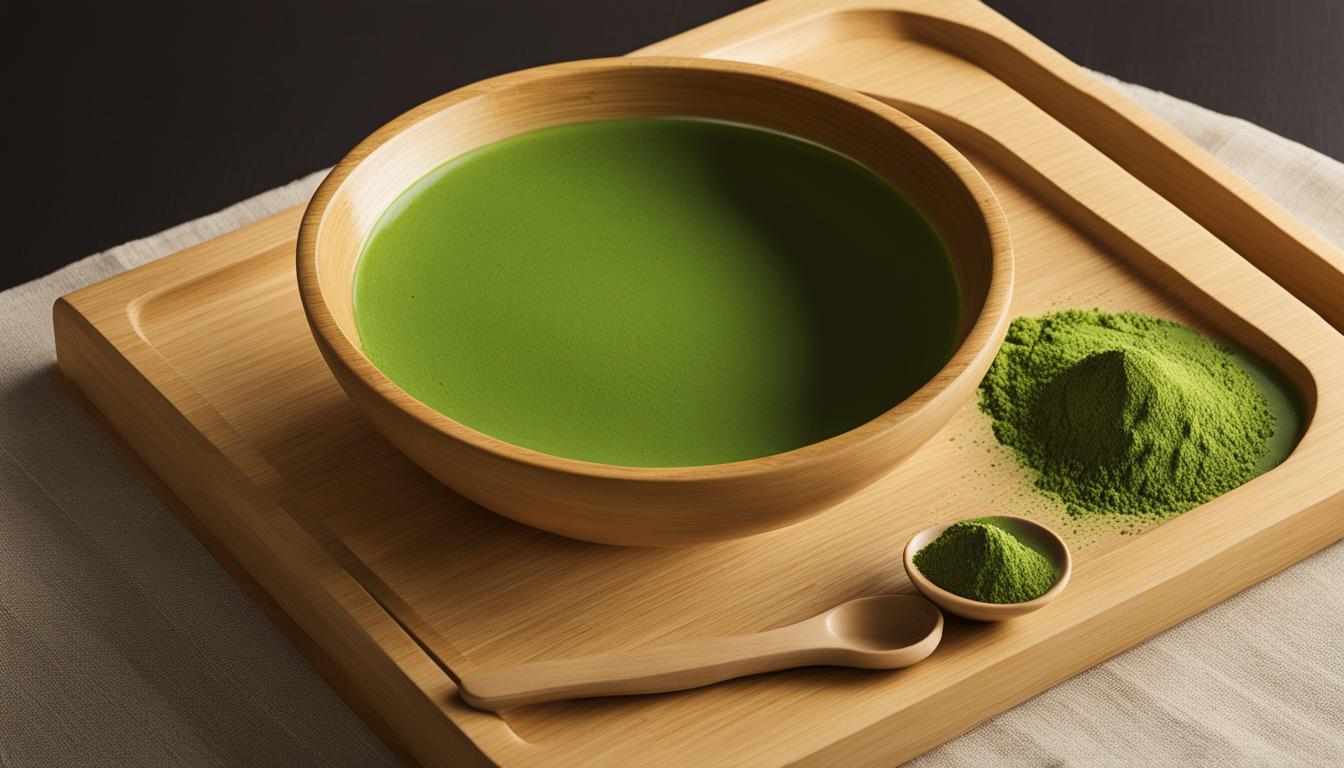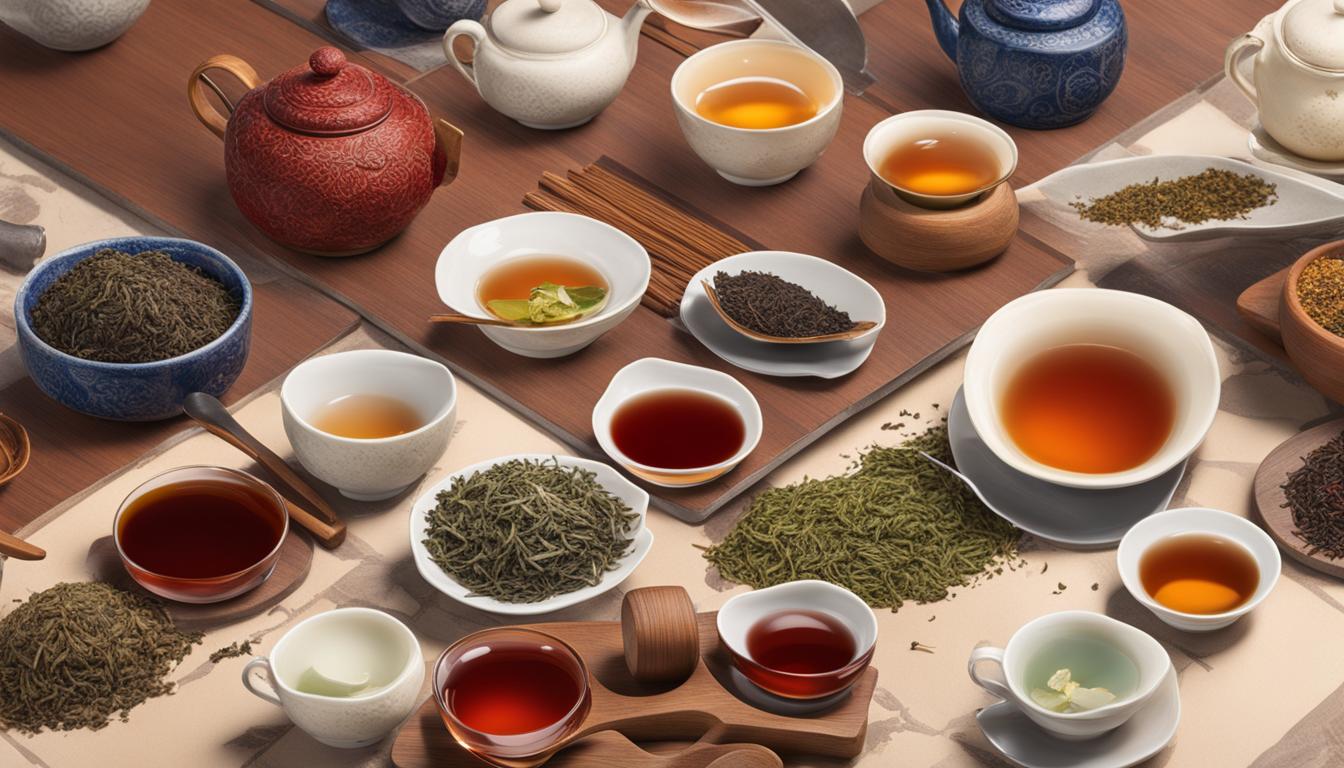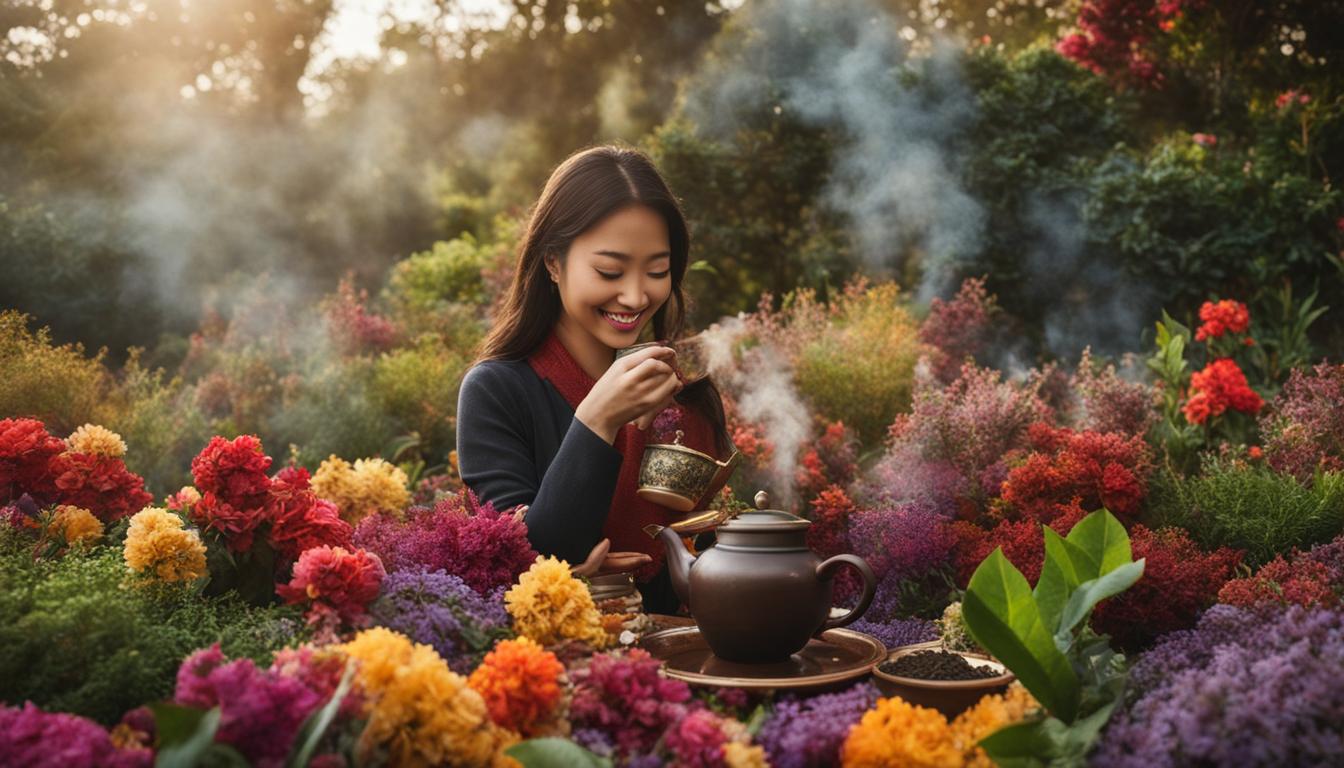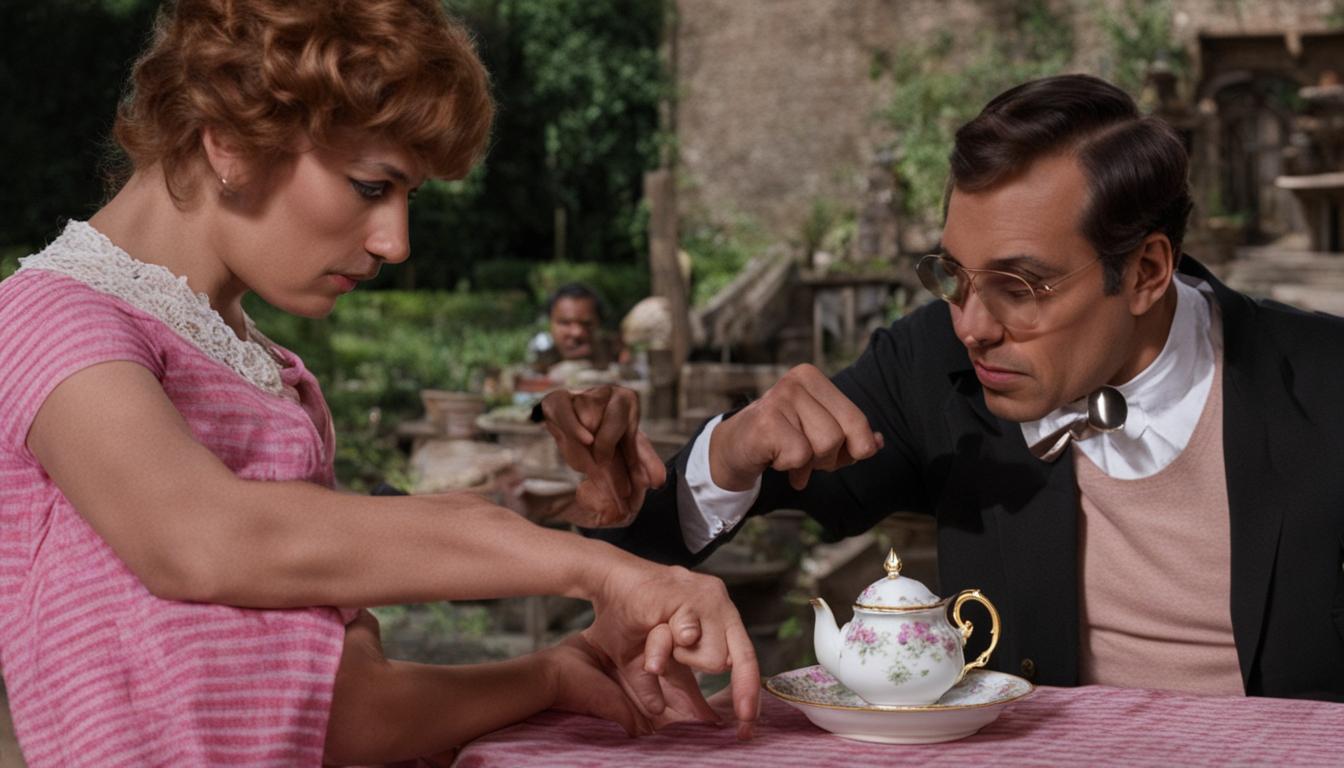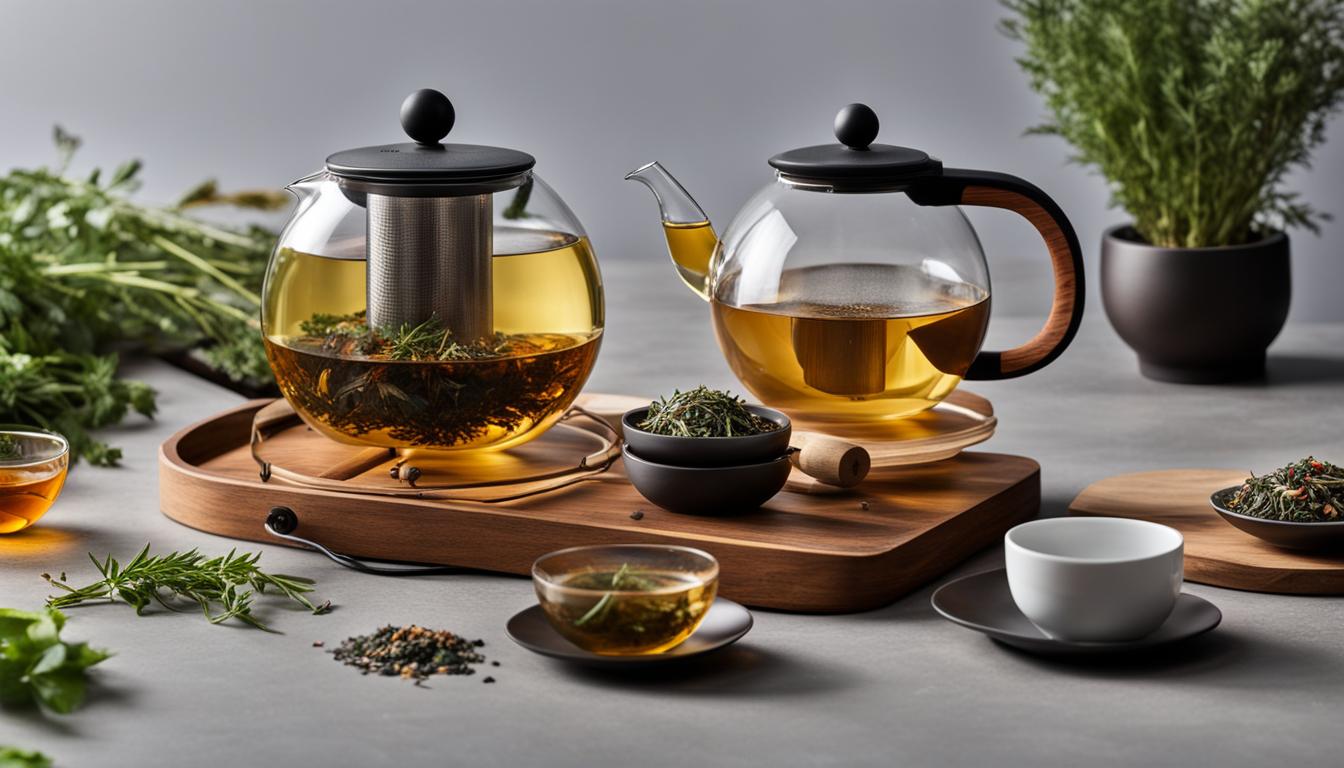Brewing the perfect cup of matcha requires the right tools and techniques. In this article, we will explore the essential equipment needed for matcha brewing and provide tips on temperature and preparation techniques.
When it comes to matcha brewing, having the right tools is crucial. From a whisk to a tea strainer, each tool plays a significant role in achieving the desired flavors and textures. But how do you choose the perfect matcha bowl? And what temperature should you brew at? Let’s dive in!
Key Takeaways:
- Matcha brewing requires specific tools, including a whisk, bowl, and tea strainer.
- Choosing the right matcha bowl is important for texture and presentation.
- Adjusting the water temperature is crucial to preserve delicate flavors.
- There are different techniques for preparing matcha, from traditional whisking to modern methods.
- Proper cleaning and maintenance of matcha equipment are essential.
Traditional Japanese Matcha Whisks: Essential Tools for Matcha Brewing
Making a perfect cup of matcha requires the right tools, and one of the most essential ones is the traditional Japanese matcha whisk, known as a chasen. Crafted from a single piece of bamboo, these handcrafted whisks are designed to fully emulsify the powdered tea into water, creating a smooth and frothy consistency that enhances the flavor and texture of the matcha. With a specific number of bristles, typically ranging from 40 to 100, traditional matcha whisks ensure a consistent and high-quality brew.
For beginners or those seeking a convenient alternative, an electric milk frother can be used as a substitute for a traditional whisk. This handy device can quickly whisk the matcha powder and water together, achieving a similar frothy texture. However, for those who appreciate the authenticity and artistry of traditional matcha brewing, a handcrafted chasen provides a unique and immersive experience.
Using a traditional matcha whisk adds a touch of elegance to the brewing process. As we whisk the matcha, we can appreciate the artistry and craftsmanship that goes into creating these intricate tools. It’s a beautiful blend of tradition and innovation, connecting us to the rich heritage of matcha in Japan.
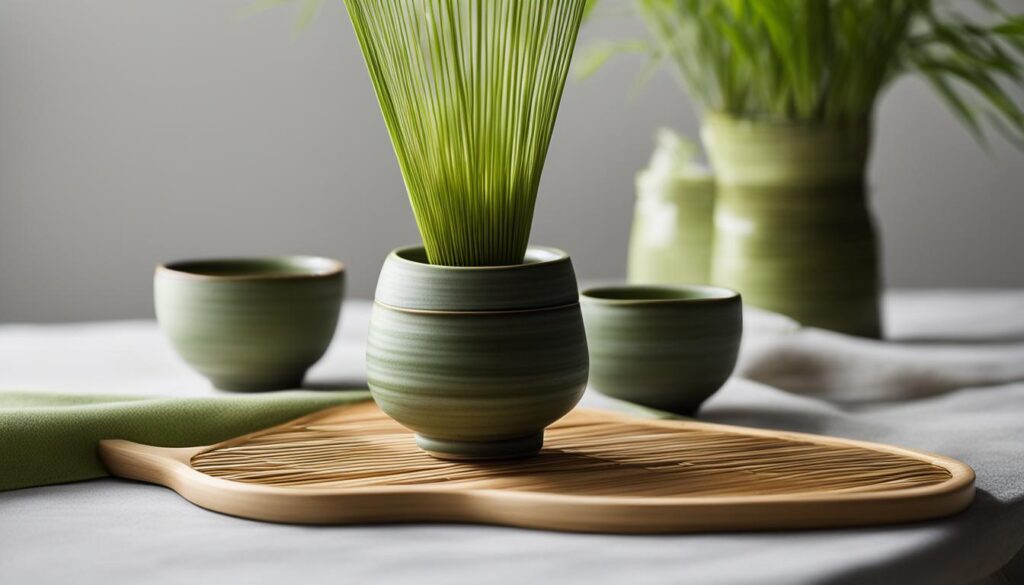
Handcrafted Matcha Accessories
In addition to the matcha whisk, there are other handcrafted accessories that can enhance your matcha brewing experience. Whisk keepers, for example, are designed to maintain the shape and integrity of the whisk, ensuring its longevity. These small holders not only protect the delicate bristles but also add a decorative element to your matcha preparation area.
Other handcrafted matcha accessories, such as chasaji (serving spoons) and chazutsu (tea canisters), can also elevate the overall aesthetic and functionality of your matcha brewing ritual. These accessories not only serve a practical purpose but also reflect the attention to detail and craftsmanship that goes into the world of matcha.
| Traditional Whisks | Electric Frothers |
|---|---|
| Handcrafted from bamboo | Convenient and easy to use |
| Creates a smooth, frothy consistency | Quickly whisks matcha powder and water together |
| Requires practice for proper technique | Great for beginners or when time is limited |
Choosing the Perfect Matcha Bowl: Matcha Bowl Selection Guide
When it comes to the art of matcha brewing, the choice of matcha bowl, or chawan, is crucial. The right matcha bowl can enhance the overall matcha experience, from the texture and flavor of the tea to the presentation of the final cup. Considerations such as shape, size, weight, texture, and glaze all play a role in selecting the perfect matcha bowl.
Traditional matcha bowls are typically simple and deep, with a diameter of around 5 inches. These bowls are designed to allow for easy whisking and frothing of the matcha, resulting in a smooth and creamy texture. However, there are also modern variations available, such as matcha bowls with pour lips for easier pouring and serving.
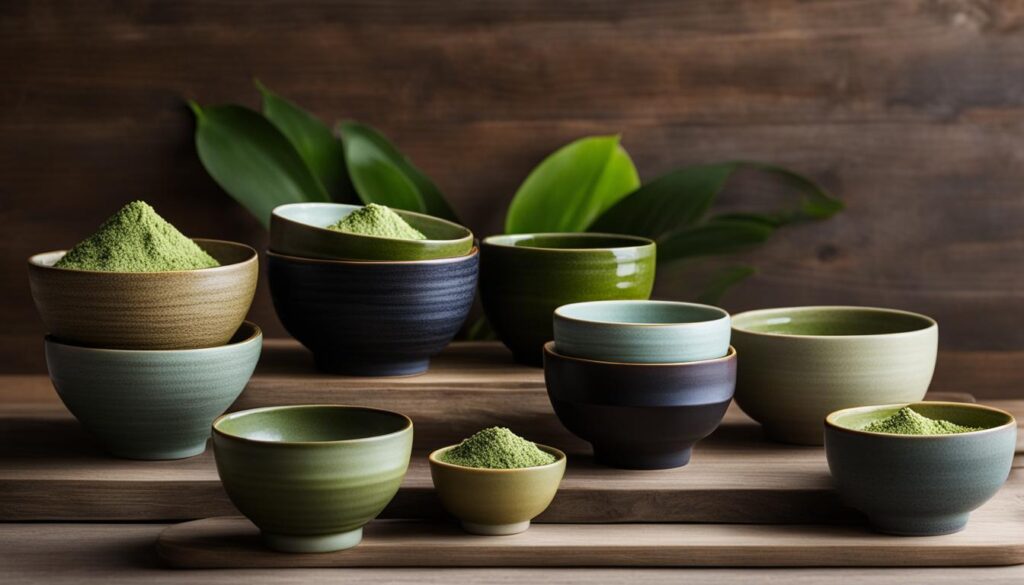
Ceramic matcha bowls come in a variety of finishes and styles, and each has its own unique qualities. For example, the katakuchi style matcha bowl features a pour lip, making it easy to pour the prepared matcha into a cup or bowl. Other styles may have textured exteriors for a more tactile experience or a glossy glaze for a refined and elegant look.
When choosing a matcha bowl, it’s important to consider your personal preferences and the type of matcha you will be brewing. Different matcha bowls can complement different types of matcha, whether it be a vibrant ceremonial grade matcha or a more robust culinary grade matcha. By selecting the perfect matcha bowl, you can elevate your matcha brewing experience and enjoy each cup to its fullest.
Achieving the Perfect Matcha Texture: Tea Strainer and Whisking Technique
To achieve the smoothest matcha texture, one important tool to use is a tea strainer. The tea strainer helps to sift the matcha powder, ensuring that there are no clumps and resulting in a smooth and consistent texture. Simply place the tea strainer over the matcha bowl and gently tap it to sift the powder through. This step is especially important when using ceremonial grade matcha, as it tends to be more delicate and can easily clump together.
Once the matcha powder has been sifted, it’s time to whisk it into a frothy texture. The traditional whisking technique involves using a bamboo whisk called a chasen. Hold the whisk in one hand and use the other hand to hold the matcha bowl steady. Begin whisking the matcha in a quick, zig-zag motion, making sure to whisk vigorously to create the desired frothiness. This process helps to fully emulsify the matcha and blend it with the water, resulting in a smooth and flavorful cup of matcha.
When whisking matcha, it’s crucial to pay attention to the water temperature. Matcha brewing temperature tips suggest using water that is around 175°F (80°C) to avoid a bitter taste. Water that is too hot can scorch the delicate matcha leaves and result in a less enjoyable cup. It’s recommended to heat the water to the desired temperature and then allow it to cool slightly before adding it to the matcha powder. This way, you can preserve the delicate flavors and enjoy the full experience of ceremonial grade matcha.
| Tea Strainer Benefits | Whisking Technique Tips | Matcha Brewing Temperature Tips |
|---|---|---|
| Removes clumps for a smooth texture | Use a bamboo whisk in a zig-zag motion | Water temperature should be around 175°F (80°C) |
| Ensures even distribution of matcha powder | Whisk vigorously to create frothiness | Allow hot water to cool slightly before adding it |
| Deeper infusion of flavors | Hold matcha bowl steady with one hand | Preserves delicate flavors of ceremonial grade matcha |
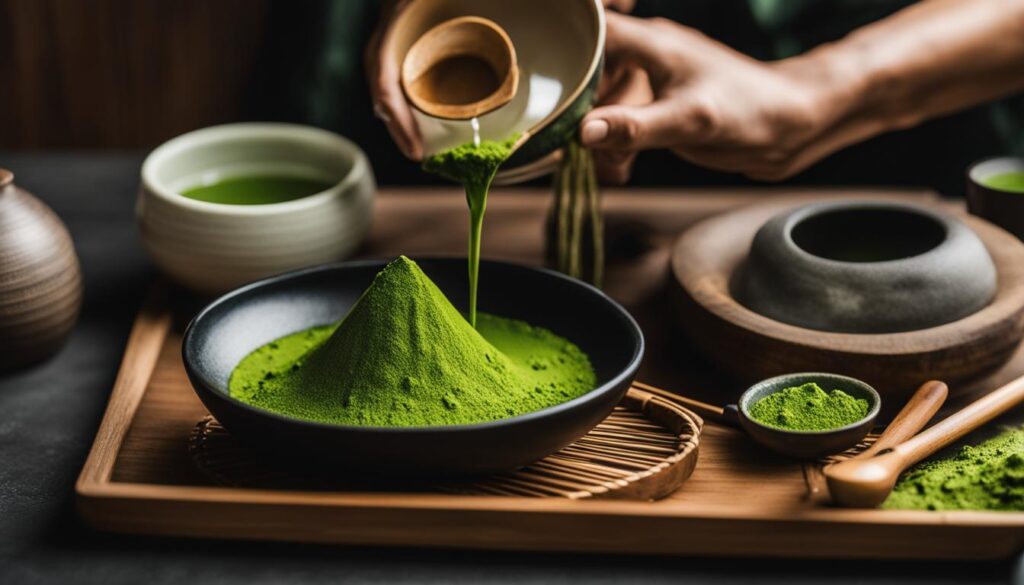
Cleaning Matcha Equipment
After enjoying a delicious cup of matcha, it’s important to clean and maintain your matcha equipment. This includes the whisk, bowl, and tea strainer. Cleaning matcha equipment is relatively simple, as all you need is warm water and a gentle touch. Avoid using soap on the bamboo whisk, as it can leave a residue and affect the flavors of future cups of matcha.
To clean the whisk, rinse it under warm water, gently removing any matcha residue. Then, squeeze out any excess water and allow the whisk to air dry. It’s recommended to place the whisk in a whisk keeper to help maintain its shape and prolong its lifespan. This will ensure that the whisk remains in optimal condition for future brewing sessions.
The matcha bowl and tea strainer can be cleaned with warm water and a soft cloth. Gently wipe the surfaces to remove any remaining matcha powder or residue. Ensure that the bowl and strainer are completely dry before storing them to prevent any potential moisture damage. By properly cleaning and caring for your matcha equipment, you can continue to enjoy the perfect matcha texture and flavors with each cup.
Modern Matcha Making Devices: Glass Tea Bottle and Matcha Accessories
When it comes to brewing matcha, traditional tools are not the only option. Modern matcha making devices can provide convenience and additional ways to enjoy this vibrant green tea. One such device is the glass tea bottle with a built-in tea infuser. This innovative bottle allows you to brew iced matcha effortlessly. Simply add matcha powder and water, give it a good shake, and voila! You have a refreshing glass of cold matcha ready to be enjoyed on the go.
But modern matcha making isn’t just about convenience—it’s about adding a touch of elegance to the matcha brewing experience. Handcrafted matcha accessories, such as chasaji (serving spoons) and chazutsu (tea canisters), can enhance the preparation and storage of matcha. These beautifully crafted tools not only serve a practical purpose but also add a sense of artistry to the ritual of preparing and serving matcha.
“The glass tea bottle infused with matcha brings a contemporary twist to traditional matcha brewing. It’s a convenient way to enjoy the refreshing taste of matcha on the go.” – Matcha Enthusiast
Glass Tea Bottle with Built-in Tea Infuser
| Product Features | Benefits |
|---|---|
| Easy to use | Brew matcha quickly and effortlessly |
| Portable | Enjoy matcha on the go |
| Durable glass construction | Long-lasting and eco-friendly |
| Built-in tea infuser | No need for additional tools |
With modern matcha making devices like the glass tea bottle and handcrafted accessories, you can elevate your matcha experience and indulge in the rich flavors of this beloved tea. Whether you prefer the convenience of on-the-go matcha or the artistry of beautifully crafted tools, there’s something for everyone in the world of modern matcha brewing.
Cleaning and Caring for Matcha Equipment: Whisk Keepers and Proper Maintenance
Proper cleaning and maintenance of matcha equipment are crucial to preserve their quality and prevent cross-contamination of flavors. One essential tool for maintaining the shape and lifespan of your matcha whisk is a whisk keeper. This small, specially designed stand helps the whisk retain its form when not in use, preventing it from bending or losing its shape. Simply place the whisk on the holder and let it air dry, allowing the bristles to stay intact and ready for your next matcha session. Whisk keepers are available in various styles and materials, adding a touch of elegance to your matcha brewing setup.
When it comes to cleaning your matcha whisk, simplicity is key. Rinse the whisk with warm water immediately after each use, gently removing any residue from the bristles. Avoid using soap, as it can leave behind unwanted flavors in the whisk. Once cleaned, let the bamboo whisk air dry naturally. This will help maintain its integrity and prevent the growth of mold or mildew.
“Proper cleaning and maintenance of matcha equipment are essential to preserve their quality and prevent cross-contamination of flavors.”
Aside from the whisk, other matcha equipment, such as matcha bowls and accessories, require proper care as well. Ensure that you clean your matcha bowl thoroughly after each use, using warm water and a soft cloth to gently wipe away any tea residue. Avoid using abrasive materials or harsh chemicals, as these can damage the delicate glaze of the bowl. Storing your matcha equipment in a dry and temperate environment will help prolong their lifespan and maintain their integrity.
As you embrace the art of matcha brewing, remember that proper cleaning and caring for your matcha equipment is just as important as the brewing process itself. By using a whisk keeper, cleaning your whisk with warm water, and storing your matcha equipment properly, you can ensure that every matcha experience is one filled with exquisite flavors and lasting enjoyment.
Conclusion
So there you have it, the essential tools and techniques for mastering the art of matcha brewing. With the right matcha brewing tools, such as a whisk, bowl, tea strainer, and glass tea bottle, you’ll be well-equipped to create the perfect cup of matcha. Remember to choose a matcha bowl that suits your preferences, as it can greatly affect the texture and presentation of the tea.
Adjusting the water temperature is key to unlocking the full flavors of matcha and avoiding any unpleasant bitterness. And don’t forget to follow proper whisking techniques to achieve that frothy and smooth consistency we all love.
If you’re looking for a more modern approach, there are matcha-making devices, like the glass tea bottle with a built-in tea infuser, that can simplify the brewing process and allow you to enjoy matcha on the go. Just shake and sip!
Lastly, taking care of your matcha equipment is essential. Use a whisk keeper to maintain the shape of your whisk and ensure its longevity. Clean your equipment with warm water and avoid using soap on the whisk. And remember to store your matcha tools in a dry and temperate environment. By following these tips and techniques, you’ll be well on your way to becoming a matcha brewing master!
FAQ
What tools do I need for brewing matcha?
The essential tools for matcha brewing include a whisk, whisk keeper, bowl, tea strainer, glass tea bottle, and a matcha scoop. These tools are essential for proper emulsification and preparation of matcha.
How do I choose the right matcha bowl?
Matcha bowls come in various styles and sizes. It is important to consider factors such as shape, size, weight, texture, and glaze when choosing the perfect matcha bowl for a satisfying matcha experience.
What is the proper water temperature for brewing matcha?
Adjusting the water temperature is crucial to preserve the delicate flavors of matcha and prevent bitterness. It is important to use water that is not too hot, as it can affect the taste of the matcha.
What is the best technique for whisking matcha?
Whisking matcha involves a zig-zag motion to fully emulsify the powdered tea into water, creating a smooth and frothy texture. This whisking technique is crucial for proper emulsification of matcha.
Are there any modern matcha-making devices available?
Yes, there are modern matcha-making devices such as glass tea bottles with built-in tea infusers. These devices provide convenience and simplify the process of brewing matcha, especially for iced matcha.
How do I clean and maintain matcha equipment?
Cleaning matcha equipment, such as the whisk and bowl, is essential to maintain their quality. Bamboo whisks can be cleaned with warm water and air-dried, while matcha bowls and other accessories can be gently cleaned with a soft cloth.

